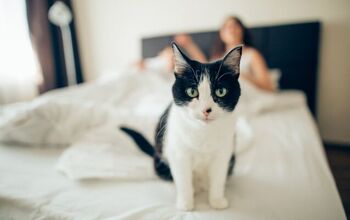Oriental Bicolor


About Oriental Bicolor
Today’s Oriental Bicolor originated in the United States in 1979, when Lindajean Grillo began crossing bicolor American Shorthair cats with Siamese cats. Out of all of the offspring, she picked the best bicolor kitties to then mate back to Orientals or Siamese. In 1983, the breed was recognized by TICA (The International Cat Association).
Throughout the 1980s, breeders in Europe (the Netherlands and France, in particular) also started an Oriental Bicolor breeding program. They used a white and red Moroccan female street cat and later used a black and white Cornish Rex. More cats were then imported from the United States, as the goal was to establish different lines to mate a bicolor cat with another bicolor cat and create a coat that had the right proportion of white in it, all while avoiding excessive inbreeding.
In 2004, Oriental Bicolor cats were imported into the United Kingdom. By 2008, the breed received Provisional Status with the GCCF (The Governing Council of the Cat Fancy), as the breed became popular rather quickly.
Oriental Bicolor kitties are known for their outgoing, social, and affectionate personality.
Oriental Bicolor kitties are known for their outgoing, social, and affectionate personality. They are intelligent and active cats that need to have plenty of interaction with their human family members, as they prefer to be the center of attention.
It is also a great idea to give your Oriental Bicolor cat a range of toys to play with in order to prevent boredom and keep him physically active and mentally stimulated.
These curious and talkative felines will get along with everyone, including other cats, pets, and children, so they make ideal family companions.
One of the first things that you will notice when you look at an Oriental Bicolor is its pointed or angular face. When you observe these cats from the front, you will notice that they have a triangular face shape, along with an expression that is intelligent and alert. And when observed from the side, the nose of the Oriental Bicolor should be straight, while the chin is strong and features a level bite. The tip of the cat’s nose will line up with the tip of the chin as well.
The eyes will slant towards the cat’s nose, and they will be Oriental in terms of their shape. The ears will be wide at the base, the neck will be slender and long, and the coat will be glossy and sleek.
The body, which should be balanced and proportionate throughout, will be slender and long, but the cat will be medium in size overall. The feet and legs will be fine, and the tail will be long, slender, and tapering as well.
An Oriental Bicolor should feature white fur over 1/3 of his body. The paws and face should also be white. Beyond that, these kitties can feature a wide range of beautiful colors and patterns. These colors and patterns could include black, blue, chocolate, lilac, red, cream, apricot, cinnamon, caramel, fawn, tortie, smoke, tabby, point, and shaded.
The eyes, too, can come in several shades. They can be blue or green, and some cats might have one blue eye and one green eye.
An Oriental Bicolor could have a short and fine coat that is close lying and glossy, or the coat could be medium-long, silky, glossy, and fine, lacking a wooly undercoat.
A weekly brushing session is all you really need to help keep your Oriental Bicolor looking his best. This will help remove loose fur easily and also give your cat the attention that he craves. Just keep in mind that, because this breed has a thin coat, you should brush your pet gently. Being too rough could actually damage your cat’s skin and cause what is known as brush burn.
Photo credit: Jenni Ferreira/Shutterstock; Eric Isselee/Shutterstock

Lisa Selvaggio is a freelance writer and editor, and our resident cats-pert, with certifications in pet nutrition and pet first aid. She enjoys producing content that helps people understand animals better so they can give their pets a safe and happy home.
More by Lisa Selvaggio

























